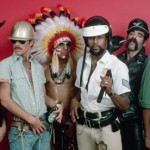Steele, Valerie and Jennifer Park. Gothic: Dark Glamour Yale University Press, 2008
Trunk, Jonny. Dressing for Pleasure: The Best of AtomAge 1972-1980 Murray & Sorrell FUEL, 2010.
S/M as fashion is not exactly the same thing as S/M as a sexual practice. There’s considerable overlap, but they have followed different paths into the mainstream.
As of 2010, we’re so used to seeing BDSM/fetish fashion in Hot Topic, in music videos, on fashion runways and in big budget movies that it is hard to believe that the look was ever countercultural.
Once upon a time however, the only place you’d see pictures of people in full leather or rubber would have been in self-published magazines and catalogues like AtomAge. There were plenty of professionally produced and shot images, but what was really interesting (at least for my purposes) were the reader submissions. The pictures of leather and rubber fetishists, shot by amateurs (in the literal sense) in mundane-looking homes, look like some kind of outsider art, and have that kind of totemic power. These were people driven by some kind of deep-seated, insistent muse, without reward of money or even outsider cool cachet.
John Sutcliffe… attempted to suppress his lifetime attachment to leather, which had been diagnosed as a symptom of mental illness. Following psychiatric help and other attempts at finding a ‘cure’, Sutcliffe suffered both a mental and marital breakdown. He moved out of his home with a little more than a suit, a tape recorder and a camera.
…
It has been suggested that Sutcliffe’s pieces [leather and vinyl suits] heavily influenced the look of the Emma Peel character in the mid-60s television show The Avengers, and he designed and created the costumes for the stage version of the series. He found a strong theatrical demand for his work, making leather costumes for The Valkyrie in a London production of Wagner’s Ring Cycle, and futuristic space suits for sci-fi movies such as Hammer Film’s Moon Zero Two (1969) among others. In the late 1960s the pop artist Allen Jones employed AtomAge to dress a number of his art projects, including the leather outfits worn by his female Chair, Table and Hat Stand (1969) sculptures.
Trunk, pg. 7
Fetish was adopted (or appropriated, less charitably) by the mainstream for the same reasons and by the same means as punk: visually striking, carrying the connotations of the outsider (the criminal for punks, the mentally and sexually peculiar for fetishists and the prostitute for both). The Vivienne Westwood-Malcolm McLaren partnership was one channel for this propagation in the UK.
Another channel:
Meanwhile, in Paris, the fashion designer Karl Lagerfeld held his famous Soiree Moratoire Noire party on October 24, 1977, after the Chloe fashion show. The invitation read: “Moratoire Noire – tenue tragique exigee absolument noire” (Black Moratorium – totally black tragic dress required). The party was arranged by Lagerfeld’s friend Jacques de Bascher and was intended as a transgressive saturnalia, complete with S&M performances and thousands of people dressed all in black. As Lagerfeld said, “We have had enough of those parties full of blond women with year-round tans.”
The party-goers, however, were not wearing the kind of worldly, elegant, and alluring black that fashion magazines had promoted since the 1950s. The phenomenon known as “terrorist chic” had moved from the periphery, where it was associated particularly with the gay leatherman style, to the center of fashion. The French designer Claude Montana attended Lagerfeld’s party dressed entirely in black leather, evoking both the sadomasochistic allure of leathersex and the “fascist chic” of black SS uniforms. Montana could simultaneously embrace the subcultural look of S&M black leather and also set trends within the world of high fashion, just as Westwood could be both a punk and a fashion designer. Indeed, so ubiquitous was the look that even the Montgomery Ward department store in America featured S&M-style black leather fashion in the 1970s.
Steele, pg. 33-35
Jennifer Park’s accompanying section deals with gothic music and fashion, positing the Velvet Underground as the prototype of Gothic music, which was inseparable from fashion. The German influence on British music was a case of appropriating the trappings of the despised Other as a rebellion:
Visually, punks appropriated despised symbols, such as the Nazi swastika, as elements of provocation. What could be worse then [sic] challenging everything Great Britain – a righteous victor of the Second World War – fundamentally stood for than by wearing what the enemy wore?
Steele, Pg. 125
Joy Division particularly made use of Nazi imagery (itself a movement built through imagery) in their album art and personal style. There’s an odd historical irony that the movement that thought itself the saviour of civilization against the decadent barbarians (c.f. the original Goths) would have their trappings poached by Goths as a decadent, barbaric rebellion against mainstream society. (C.f. Jean Genet)



